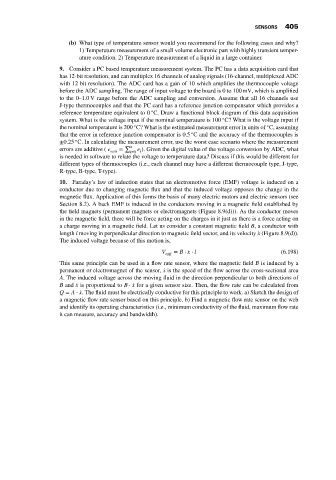Page 419 - Mechatronics with Experiments
P. 419
Printer: Yet to Come
October 9, 2014 8:1
JWST499-c06
JWST499-Cetinkunt
SENSORS 405 254mm×178mm
(b) What type of temperature sensor would you recommend for the following cases and why?
1) Temperature measurement of a small volume electronic part with highly transient temper-
ature condition. 2) Temperature measurement of a liquid in a large container.
9. Consider a PC based temperature measurement system. The PC has a data acquisition card that
has 12-bit resolution, and can multiplex 16 channels of analog signals (16-channel, multiplexed ADC
with 12 bit resolution). The ADC card has a gain of 10 which amplifies the thermocouple voltage
before the ADC sampling. The range of input voltage to the board is 0 to 100 mV, which is amplified
to the 0–1.0 V range before the ADC sampling and conversion. Assume that all 16 channels use
J-type thermocouples and that the PC card has a reference junction compensator which provides a
◦
reference temperature equivalent to 0 C. Draw a functional block diagram of this data acquisition
◦
system. What is the voltage input if the nominal temperature is 100 C? What is the voltage input if
◦
◦
the nominal temperature is 200 C? What is the estimated measurement error in units of C, assuming
◦
that the error in reference junction compensator is 0.5 C and the accuracy of the thermocouples is
◦
±0.25 C. In calculating the measurement error, use the worst case scenario where the measurement
∑ n
errors are additive ( e sum = i=0 e ). Given the digital value of the voltage conversion by ADC, what
i
is needed in software to relate the voltage to temperature data? Discuss if this would be different for
different types of thermocouples (i.e., each channel may have a different thermocouple type, J-type,
R-type, B-type, T-type).
10. Faraday’s law of induction states that an electromotive force (EMF) voltage is induced on a
conductor due to changing magnetic flux and that the induced voltage opposes the change in the
magnetic flux. Application of this forms the basis of many electric motors and electric sensors (see
Section 8.2). A back EMF is induced in the conductors moving in a magnetic field established by
the field magnets (permanent magnets or electromagnets (Figure 8.9(d))). As the conductor moves
in the magnetic field, there will be force acting on the charges in it just as there is a force acting on
a charge moving in a magnetic field. Let us consider a constant magnetic field B, a conductor with
length l moving in perpendicular direction to magnetic field vector, and its velocity ̇ x (Figure 8.9(d)).
The induced voltage because of this motion is,
V emf = B ⋅ ̇ x ⋅ l (6.198)
This same principle can be used in a flow rate sensor, where the magnetic field B is induced by a
permanent or electromagnet of the sensor, ̇ x is the speed of the flow across the cross-sectional area
A. The induced voltage across the moving fluid in the direction perpendicular to both directions of
B and ̇ x is proportional to B ⋅ ̇ x for a given sensor size. Then, the flow rate can be calculated from
Q = A ⋅ ̇ x. The fluid must be electrically conductive for this principle to work. a) Sketch the design of
a magnetic flow rate sensor based on this principle. b) Find a magnetic flow rate sensor on the web
and identify its operating characteristics (i.e., minimum conductivity of the fluid, maximum flow rate
it can measure, accuracy and bandwidth).

